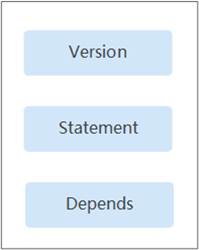RBAC Syntax of RBAC Policies¶
Policy Structure¶
An RBAC policy consists of a Version, a Statement, and Depends.

Figure 1 RBAC policy structure¶
Policy Syntax¶
When selecting a policy for a user group, click  below the policy to view the details of the policy. The DWS Administrator policy is used as an example to describe the syntax of RBAC policies.
below the policy to view the details of the policy. The DWS Administrator policy is used as an example to describe the syntax of RBAC policies.

Figure 2 Syntax of RBAC Policies¶
{
"Version": "1.0",
"Statement": [
{
"Effect": "Allow",
"Action": [
"dws:dws:*"
]
}
],
"Depends": [
{
"catalog": "BASE",
"display_name": "Server Administrator"
},
{
"catalog": "BASE",
"display_name": "Tenant Guest"
}
]
}
Parameter | Meaning | Value | |
|---|---|---|---|
Version | Policy version | The value is fixed to 1.0. | |
Statement | Action | Operations to be performed on GaussDB(DWS) | Format: Service name:Resource type:Operation. dws:dws:*: Permissions for performing all operations on all resource types in GaussDB(DWS). |
Effect | Whether the operation defined in an action is allowed |
| |
Depends | catalog | Name of the service to which dependencies of a policy belong | Service name Example: BASE |
display_name | Name of a dependent policy | Policy name Example: Server Administrator |
Note
When using RBAC for authentication, pay attention to the Depends parameter and grant other dependent permissions at the same time.
For example, the DWS Administrator permission depends on the Server Administrator and Tenant Guest permissions. When granting the DWS Administrator permission to users, you also need to grant the two dependent permissions to the users.